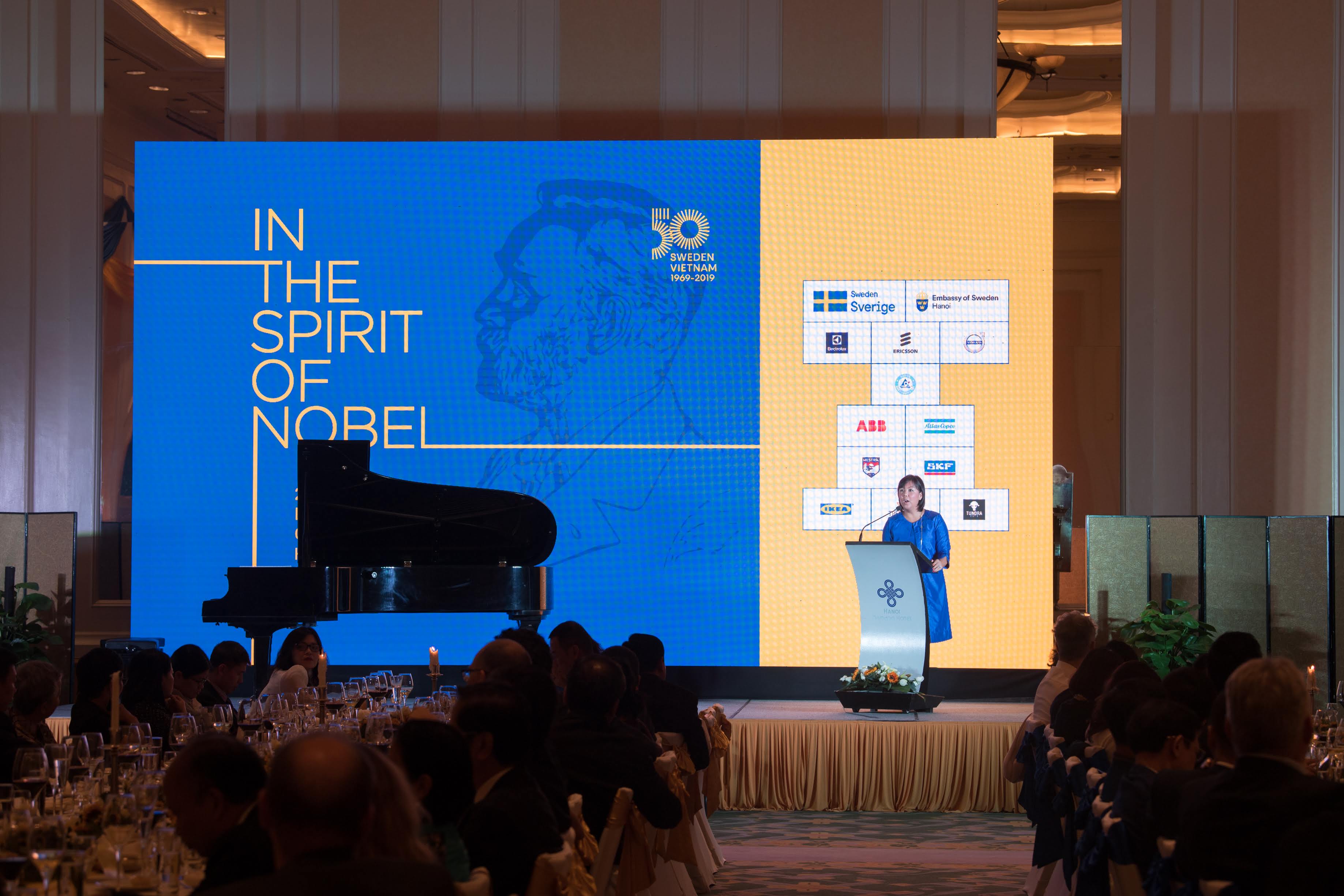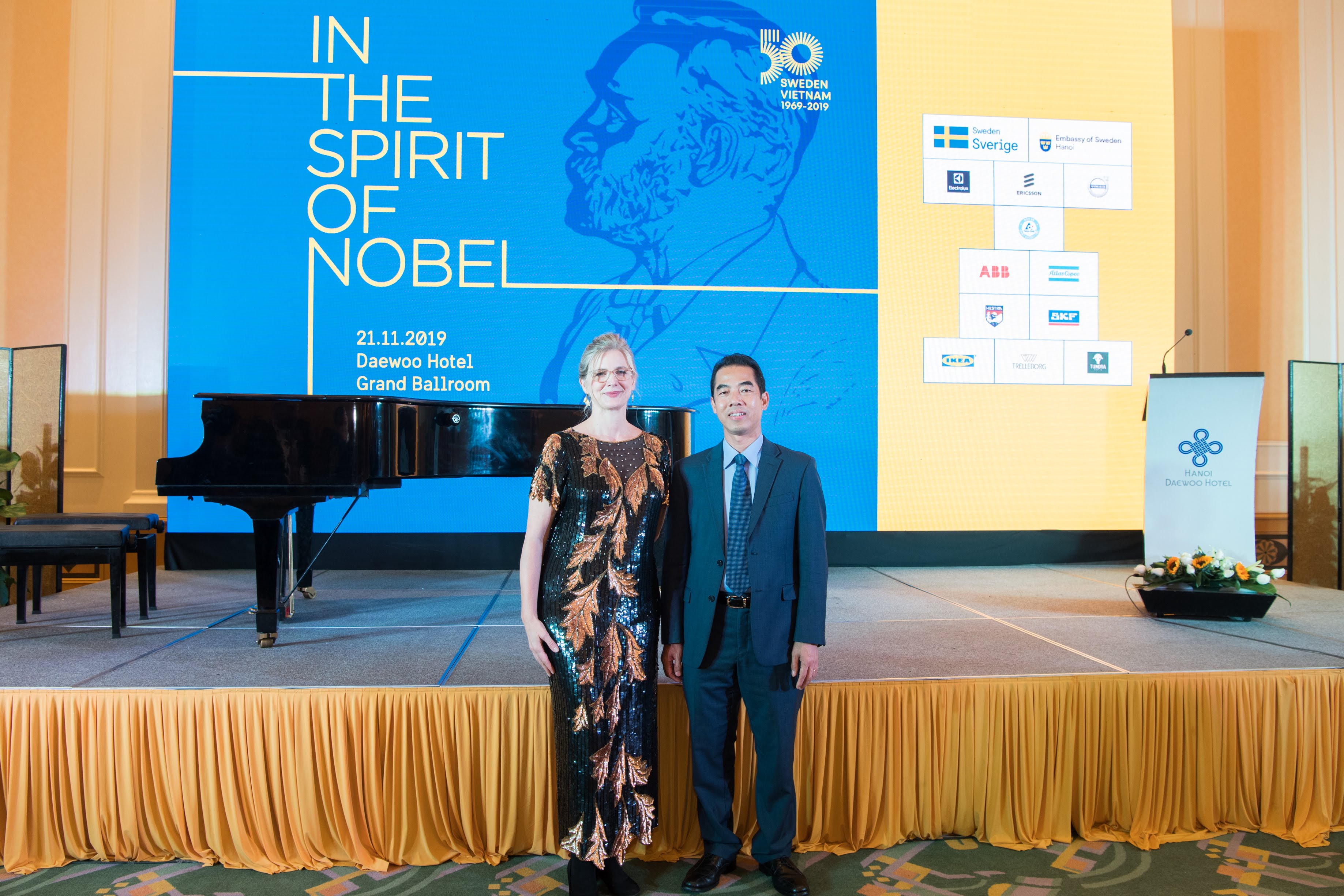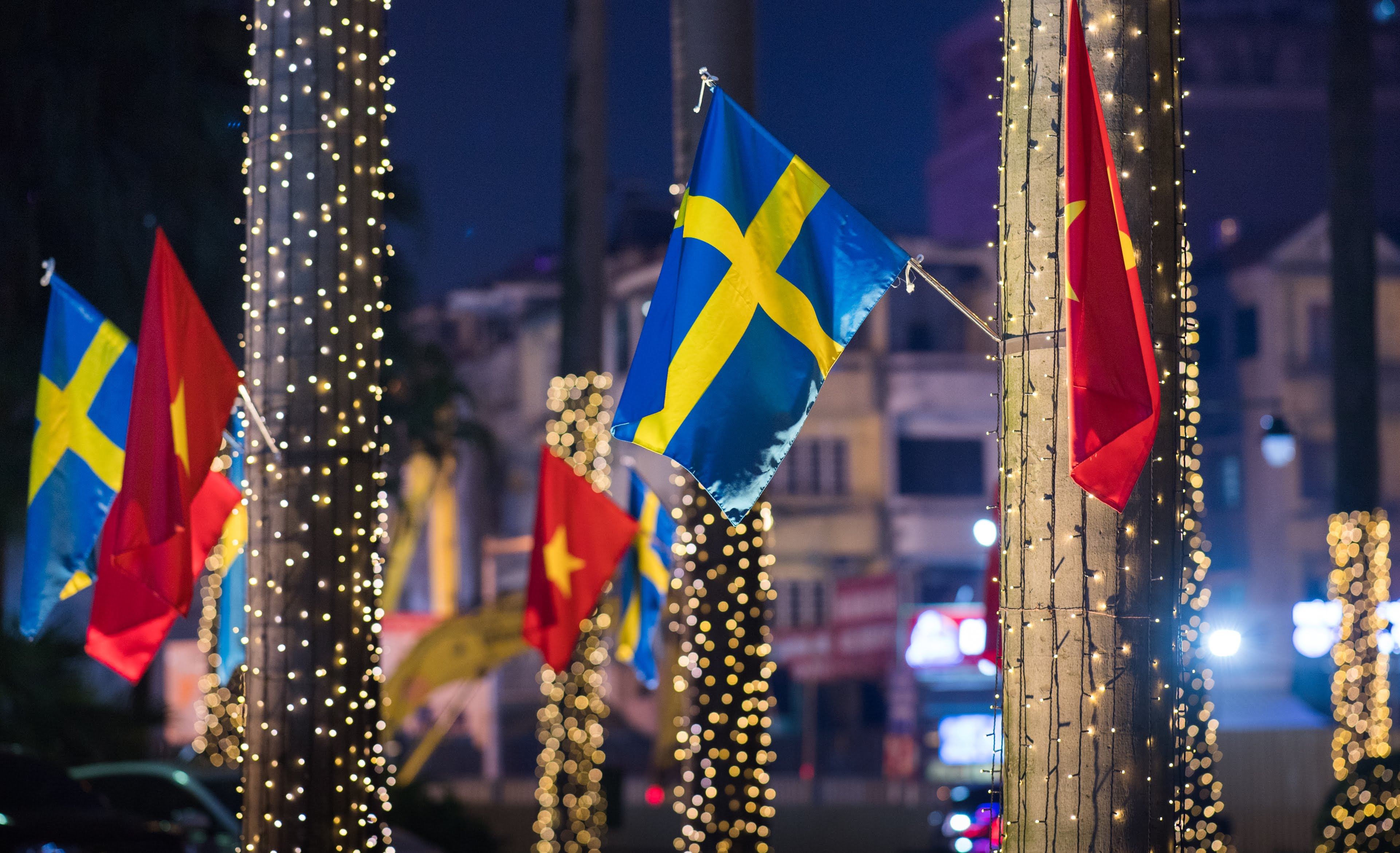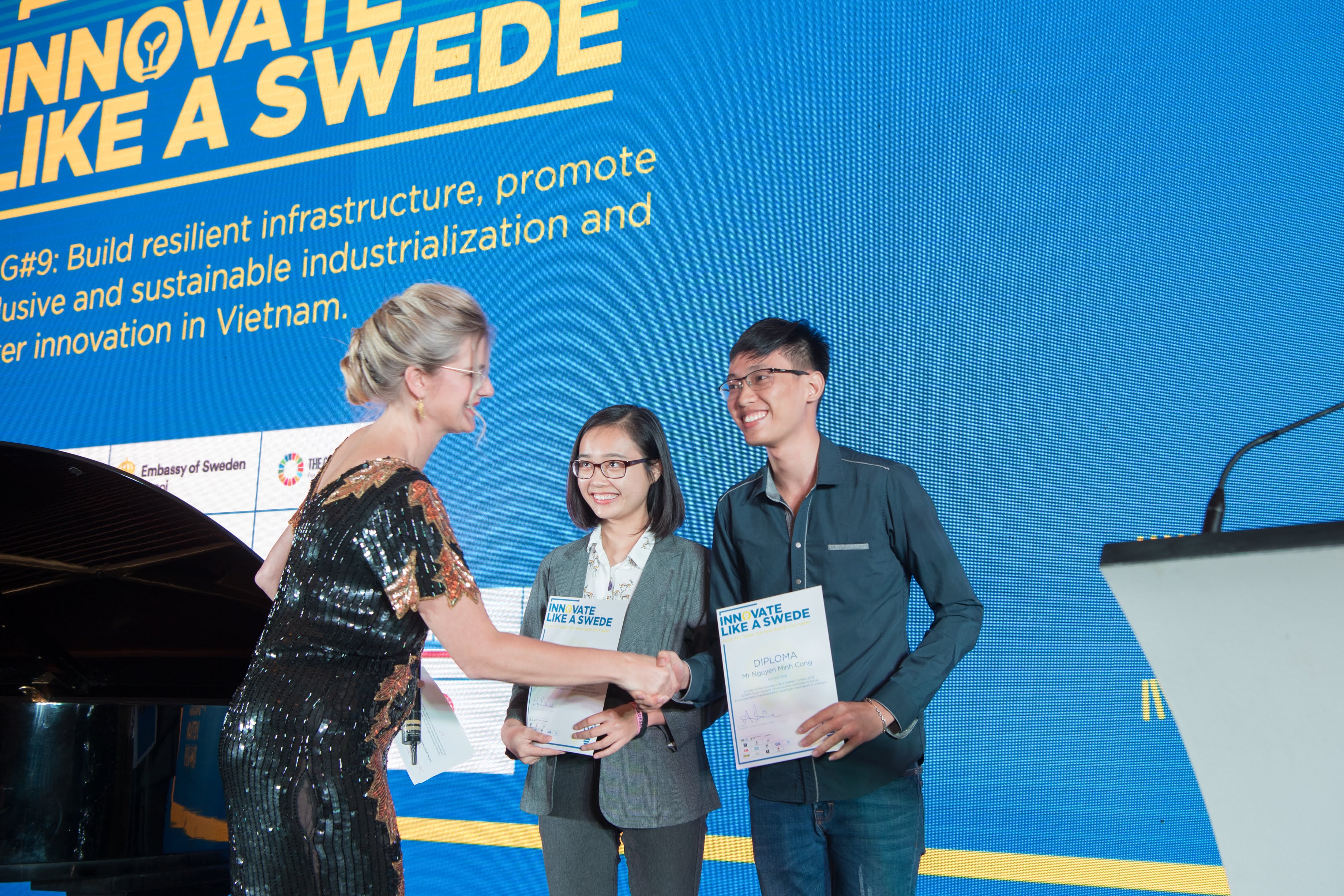By Christina Ameln, CSR | Sustainability Advisor –
December 10 is the official Nobel Banquet in Stockholm, Sweden with many other celebratory events around it including in Vietnam. The Swedish Embassy in Vietnam hosted in Hanoi on November 21, 2019 an event – In the Spirit of Nobel – to highlight the achievements of Nobel; its winners; and lift up sustainability and innovation. Here is a version of the inspiration speech on sustainability and innovation titled ‘What would Alfred Nobel think?’ delivered by CSR and Sustainability expert Christina Ameln with examples from Ericsson, IKEA; H&M, EZLand and more; with thoughts and concepts on problem-solving, collective ownership, collaboration, leadership and courage.
Introduction
This is the day I have been waiting for since I was asked to attend this dinner and give the inspiration speech.
There is a lot riding on this speech. I have been working on sustainability and social impact for over 20 years. But like many of us, I spend most of my time in my own bubble, speaking to the already-converted.
So, of course I am nervous. Nervous that that my voice will shake. Nervous that I will get lost in my own jargon. Nervous that I might lose some of you in the first couple of minutes. But promoting social impact is a life-long passion, so I couldn’t pass up this chance.
Add to this, the intimidating nature of Alfred Nobel himself.
As you know, Alfred Nobel, the key person and the instigator of the Nobel Peace Prize,was a chemist, engineer and inventor. We are here to celebrate his achievements – and those of all the amazing people who have won this prize.
Yes, Nobel was a chemist, an engineer and an inventor.
It’s almost overwhelming. Those words bring up images of maths, science and genius – a person completely out of the norm. I feel pressured to share thoughts that even he might think and find interesting.
For the past few weeks, I have given this much thought – and now I feel more confident. Because I am convinced that Alfred Nobel would have had a lot to say on the two concepts that I will speak about tonight: sustainability and innovation.
Sustainability.
Innovation.
These words also seem a bit overwhelming, similar to chemist, engineer and inventor. Some do not understand it, some have differing views on these works and people always ask how to achieve them.
So, what do they mean?
Sustainability is defined as “meeting the needs of the present without compromising the ability of future generations to meet their own needs”.
Innovation is defined as”a new idea, creative thoughts, new imaginations, a better application or better solutions”.
Put simply, sustainability and innovation mean turning ideas into sustainable and positive impact.
In the next few minutes, I will take you on a journey – a journey that will hopefully convince you thatwe are all innovators for the greater good, capable of understanding the concepts of sustainability and innovation and integrating them into our daily lives.

In a Spirit of Nobel – Dinner 2019 hosted by the Swedish Embassy to Vietnam in Hanoi. Christina Ameln delivering her speech on sustainability and innovation.
Sustainability and Innovation in Action
I will divide my remarks tonight into four parts, highlighting four concepts that I hope you will remember beyond this wonderful dinner: problem-solving; collective ownership; collaboration; and leadership. In describing leadership, I will shine a light on some companies that are making a difference – both at home and abroad.
So, first let’s look at problem solving.
Before I ever heard the words sustainability and innovation,I was drawn to the creation of new ideas. Ever since I can remember, I have loved the power of ideas to solve problems and create opportunities.
I also discovered early that we all have that power. Every one of us has ideas that shape both our own lives and our vision for the world. Ideas are powerful, game-changing, inspirational and impactful.
One of my passions is bringing ideas to life – and helping people solve the puzzles and face the challenges that stand in the way of realising their own ideas.
But before working on social impact, I wanted to rebel!
My Swedish father, my Lao mother and my American step-mother had all worked in some form or another on social impact under the United Nations here in Asia as well as in Africa and in other parts of the world.
As a child, and I am sure some of you can relate, I decided to do something different from my parents. I saw a different path. So instead of studying development or international relations, I went to… business school.
Very rebellious…. 🙂
I don’t think my parents were displeased with this rebellion, but it is fair to say that the original decision came as a surprise.
The rebellion continued as I started working in communications. Communications sometimes get sa bad rap, yet it has been one of the key red threads in my work on CSR and Sustainability. I brought this problem-solving mindset into my work on communications.If no one understands your idea, your aim to problem-solve or your wish to be a change-maker, you are pretty much doing it on your own. Your impact will be minimal and probably not reach beyond the people or projects right in front of you.
Good communications supports good problem-solving by facilitating learning, sharing and replication.
Second, let’s focus on collective ownership.
My father Ulf Kristoffersson started as a Blue Beret in the United Nations then led different initiatives under several UN organisations. His work focused on children, refugees and social impact. When I asked him about sustainability and innovation, he did not hesitate:
“The first priority is getting people behind you. I learned this lesson early. I remember putting in great new wells – with clean, healthy water – in remote villages in Tanzania. The idea of it being sustainable and innovative. But because we did not work with the communities beforehand and did not sufficiently engage them in our work, the wells were under-used. People preferred to drink unhealthy water that they “trusted” than what was new and uncertain.”
My father’s sustainability lesson emphasizes the importance of trust and collective ownership. The goals of sustainability and innovation cannot be “imposed” on communities. They need to come from within – that’s collective ownership.
Third, let’s consider collaboration.
Eventually I managed to combine my social impact “heritage” and my business skills. In my mid-twenties I joined a US-based not-for-profit working with private sector companies on HIV/AIDS. This was led by the late diplomat Ambassador Richard Holbrooke and he wasway ahead ofhis time. He believed that every company could make a unique contribution to the fight against HIV/AIDS– and that the public and private sectors had to collaborate.
This was innovative idea at the time,as companies were not seen as viable partners in tackling social issues. During my time with him and the Global Coalition on Business and AIDS, we saw a range of companies step up to the HIV/AIDS challenge – from banks to media outlets to cosmetics companies. And we witnessed unique and unprecedented collaboration between companies and governments as well as between companies and non-profits. It was an inspiring time, where creativity and engagement trumped suspicion and rivalries. That experience changed my world view.
It taught me that innovation across sectors is exciting and that even very different types of organizations can collaborate. In fact, it is the combining of these different perspectives that drives innovation. The really important gains were made when people and groups got out of their own “bubbles” and joined forces.

In a Spirit of Nobel – Dinner 2019 hosted by the Swedish Embassy to Vietnam in Hanoi. Ambassador Ann Måve from the Swedish Embassy in Vietnam with Vice Minister of Foreign Affairs to Vietnam, Mr To Anh Dung.
Finally,it all comes down to leadership.
Having spent many years abroad, I returned to Sweden in 2008 to work with the Swedish company SCA, a leading forest and hygiene company. My job was to bring together disparate social responsibility efforts under one umbrella. I jumped at the opportunity to work within the walls of a company to drive social impact. The challenge was to build common understandings and commitments to social impact that appealed to all SCA employees, whether they were sitting in Stockholm or some other part of the world. This needed to happen in ways that facilitated rather than hindered product innovation and quality.
Now two separate companies, SCA and Essity both continue to be leaders on sustainability and innovation. I am pleased to continue reading that companies from the Nordic regionalso continue to trailblaze.
The best news is that trailblazing is good for business!
Research recently published by World Economic Forum confirms that companies that have a positive impact on society tend to do better financially than those that side-step or downplay their social responsibilities.
It turns out that many Nordic companies have already figured this out.
The World Economic Forum data suggests that Nordic companies are social impact leaders.The research confirms that businesses that align their strategies and operations with society’s needs do well, while doing good. One of the most critical traits that stand out with these companies is leadership.
I was thrilled to be in this hub of leadership on sustainability and innovation during my time in Sweden. And I see how it continues today and in other markets such as here in Vietnam.
I asked some of Swedish corporate leaders in Vietnam what they thought of sustainability and innovation.
Ericsson:
Denis Brunetti, President of Ericsson Vietnam, Myanmar, Cambodia and Laos said:
“They walk hand-in-hand. Innovation drives sustainability”. He sees it in Ericsson’s work on the benefits of 5G and the ‘Internet of Things”, which for him promises to transform how we live and work delivering on three areas of social, economic and environmental value.
Ericsson is a partner in the Swedish Embassy’s ‘Innovate like a Swede’ initiative, because it finds this initiative inspiring. In Brunetti’s view, it embraces the values of collaboration and innovation that have made Sweden one of the most innovative and sustainable countries in the world.
His one word definition of sustainability and innovation is echoes my experience at the Global Coalition: collaboration.
IKEA:
Kanwarpreet Singh, Sustainability Compliance Manager at IKEA’s Purchasing & Logistics Operations Area in South East Asia, believes that strengthening innovation must begin with product concepts – at the initial stages of development. For example, products should embody concepts like the reduction of waste; they should be recyclable and reusable from the get-go.
He adds that sustainability and innovation are not only in the product itself, but how they are consumed. Again, the theme of collective ownership– this time between companies and their customers.
His key words for sustainability and innovation include: quality, reduce and recycle; and people.
H&M:
Xin-Yi Wong, Sustainability Manager at H&M Southeast Asia describes her company as committed “to making great fashion and design available to many people for many years to come”.
She says that the challenges H&M faces are industry-wide. With that in mind, it sees its role as leaders in their industry – to innovate, influence, collaborate and clear the way towards a truly sustainable fashion future.
She underlines that many industry challenges can be alleviated through innovation. Through its circular business model, H&M wants to minimize waste and maximize resources. Xin-Yi told me how inspired she was that H&M recently sold its first men’s sweater made using technology that converts blended textiles into new garments.
Her key words for sustainability and innovation include: collaboration, solutions and endless possibilities.

In a Spirit of Nobel – Dinner 2019 hosted by the Swedish Embassy to Vietnam in Hanoi. Sweden and Vietnam celebrate 50 years of diplomatic relations this year.
The Future Lies in Courage
As we move to the final part of my talk, I want to lift up the word courage. It lays the foundation for facing issues that are different, new and unfamiliar!
When I left SCA, I started working as an independent consultant. I wanted to explore new experiences, try new ways of working on social impact and learn more from other experts, including from corporates, not-for-profits and international organizations.
This career change coincided with my move to Vietnam – the other side of the world.
It was intimidating to realise that I was in a new country, working without the backing of a big company. How does one break into a new environment? How does one promote sustainability concepts in this market? Will anyone be interested in social impact or innovation?
I am still not a chemist, engineer or inventor. I have felt alone and apprehensive. I have made mistakes. But I have also learned a lot – and gained valuable insights.
I still feel challenged every day. But I also feel empowered, inspired, free. Learning has increased my COURAGE.
Courage is a big driver in sustainability and innovation. And now more than ever before as these two words are intertwined. I am now more convinced of this than ever.
Why?
Because of this movement towards innovating for a better world. Because in the three years, I have been in Vietnam, I see more and more companies motivated to engage sustainably and innovate for this better world.
EZLand:
Olivier Do Ngoc, Founder and CEO of EZland Vietnam, the real estate company, told me that sustainability is the longer-term smarter choice, even from a purely competitive point of view. It also drives product innovation even here in Vietnam.
His key words for sustainability and innovation include: creativity; disruption; first mover advantage; and shareholder value.
And not just big companies. Even small entrepreneurs are taking risks – and making big contributions. You don’t have to be a big company to have courage and a good idea!
Vietnam is filled with entrepreneurs that have the courage to work in innovative ways; to work for good and embed it from the beginning. They also believe that companies can do well and do good at the same time. I have loved getting to know and work with these sustainability heros over the last three years.
There are many examples here in Vietnam but consider these two examples:
AYA Cup:
Linh Le who is the creator of AYA and sees the world as a coin with 2 heads – problems and opportunities -Yin and Yang. To tackle the waste issues (a problem), she has created a re-usable cup (an opportunity) that is built around a network of participants (coffee shops and restaurants).
Her key words on sustainability and innovation include curiosity and humility.
Mark Your Wall:
My friend Adrienne de Geer started Mark Your Wall in Vietnam when she first came here 8 years ago. It is a social enterprise working with Vietnamese street art, turning this art into canvases for people’s walls. Through her company and art, the purpose is to empower young women who survived human trafficking to re-start their lives.
Her key word for sustainability and innovation include: perseverance.
We Are All Innovators
I hope this journey has accomplished its goal and inspired you to think:
We all have great ideas. We are all innovators. We are all innovators for a greater good. And we can all make unique contributions.
And I dare to hope that Alfred Nobel himself would also be convinced and have added an additional award – a Nobel Prize for Sustainability and Innovation.
Thank you to the Swedish Embassy, Ambassador Ann Måve and all its honorable guests!
In the Spirit of Nobel!
A special thank you to the Swedish Embassy of Vietnam for inviting me to talk on how we are all innovators for good. We all have the power of ideas. It was an honour to stand up and convey how intertwined sustainability and innovation are and the belief that Alfred Nobel would have also been convinced.
A special thank you to Ambassador Ann Måve and her team; and Vice Minister of Foreign Affairs, Mr To Anh Dung for the welcome speech. While I could not mention all in my speech, a special thanks to these key and inspiring people that have helped me the last weeks to shape my part of the evening: my father Ulf Kristoffersson; Kathleen Cravero, Denis Brunetti at #Ericsson; Kanwarpreet Singh Matharu at #IKEA; Xin-Yi Wong at #HM; Jennie C Ahrén at #TundraFunds; Tommy Borglund at #ForeverSustainable; Olivier Do Ngoc at #EZlandVietnam; Adrienne De Geer at #MarkYourWall; Linh Le at #AYACup; and Johan Alvin and Camilla Bjelkås at the Swedish Embassy.
And a big congratulations to the winners of “Innovate Like a Swede” initiative!

In a Spirit of Nobel – Dinner 2019 hosted by the Swedish Embassy to Vietnam in Hanoi. Ambassador Ann Måve from the Swedish Embassy in Vietnam congratulates the Innovate Like a Swede winners.
For more information on platform Sustainable Vietnam – click on Why a Sustainable Vietnam?


2 comments
[…] and Schoolab is one of many jumping on this bandwagon. For example, I talked about this recently at the Swedish Embassy Hanoi event on In the Spirt of Nobel, where it gathered Vietnamese students around the ‘Innovate Like a Swede’ […]
Thank you for your positive comment!